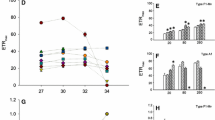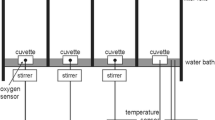Abstract
Understanding susceptibility to bleaching may indicate how corals cope with increasing seawater temperatures resulting from climate change. In Belle Mare lagoon, Mauritius, Acropora muricata colonies at reef sites but not near the coast exhibited bleaching. We compared seawater temperatures and light intensity both on a summer day and a winter day at a reef station and a near-coast station. The total phenolic contents, non-enzymatic antioxidant activities of the coral holobiont, in situ photophysiological parameters of in hospite Symbiodinium as well as their cladal diversity were assessed. Both sites had comparable maximum temperatures but fluctuations were higher in the near-coast station (2–3 °C) compared to the reef station (1–1.5 °C) on both days. Light intensity was higher on the summer day than the winter day at both stations. Higher total phenolic contents and ferrous reducing antioxidant potential were observed in near-coast colonies than in reef colonies on the summer day. Only Clade A-like Symbiodinium sp. variants were detected at both locations, but higher maximum relative electron transport rates and maximum non-photochemical quenching were measured in near-coast colonies. Our data show that the near-coast colonies exhibited enhanced photophysiological responses, antioxidant activities and increased total phenolic contents in response to higher thermal and light fluctuations. This acclimatization may explain the variability in bleaching along a coast-reef scale.






Similar content being viewed by others
References
Ainsworth TD, Thurber RV, Gates RD (2010) The future of coral reefs: a microbial perspective. Trends Ecol Evol 25:233–240. doi:10.1016/j.tree.2009.11.001
Altschul SF, Gish W, Miller W, Myers EW, Lipma DJ (1990) Basic local alignment search tool. J Mol Biol 215(3):403–10
Berkelmans R, van Oppen MJH (2006) The role of zooxanthellae in the thermal tolerance of corals: a ‘nugget of hope’ for coral reefs in an era of climate change. Proc R Soc B 273:2305–2312
Bhagooli R, Yakovleva I (2004) Differential bleaching susceptibility and mortality patterns among four corals in response to thermal stress. Symbiosis 37(1–3):121–136
Bhagooli R, Hidaka M (2006) Thermal inhibition and recovery of the maximum quantum yield of photosystem II and the maximum electron transport rate in zooxanthellae of a reef-building coral. Galaxea, J Jpn Coral Reef Soc 8:1–11. doi:10.3755/jcrs.8.1
Bhagooli R, Taleb-Hossenkhan N (2012) Thermal spatial heterogeneity and coral bleaching : implications for habitat refuges. Proc. 12th Intl. Coral Reef Symp. Cairns, Australia, 9–13 July 2012
Campos AM, Lissi EA (1996) Total antioxidant potential of Chilean wines. Nutr Res 16:385–389
Chen CA, Yang Y-W, Wei NV, Tsai W-S, Fang L-S (2005) Symbiont diversity in scleractinian corals from tropical reefs and subtropical non-reef communities in Taiwan. Coral Reefs 24:11–22. doi:10.1007/s00338-004-0389-7
Coles SL, Brown BE (2003) Coral bleaching-capacity for acclimatization and adaptation. Adv Mar Biol 46:183–223
Dove SG, Hoegh-Guldberg O, Ranganathan S (2001) Major colour patterns of reef-building corals are due to a family of GFP-like proteins. Coral Reefs 19:197–204. doi:10.1007/PL00006956
Duan X, Wu G, Jiang Y (2007) Evaluation of the antioxidant properties of litchi fruit phenolics in relation to pericarp browning prevention. Mol Basel Switz 12:759–771
Edge R, McGarvey DJ, Truscott TG (1997) The carotenoids as anti-oxidants--a review. J Photochem Photobiol B 41:189–200
Genty B, Harbinson J, Briantais J-M, Baker NR (1990) The relationship between non-photochemical quenching of chlorophyll fluorescence and the rate of photosystem 2 photochemistry in leaves. Photosynth Res 25:249–257. doi:10.1007/BF00033166
Griffin SP, Bhagooli R (2004) Measuring antioxidant potential in corals using the FRAP assay. J Exp Mar Biol Ecol 302:201–211. doi:10.1016/j.jembe.2003.10.008
Griffin SP, Bhagooli R, Weil E (2006) Evaluation of thermal acclimation capacity in corals with different thermal histories based on catalase concentrations and antioxidant potentials. Comp Biochem Physiol A Mol Integr Physiol 144:155–162. doi:10.1016/j.cbpa.2006.02.017
Higuchi T, Fujimura H, Arakaki T, Oomori T (2008) Activities of antioxidant enzymes (SOD and CAT) in the coral Galaxea fascicularis against increased hydrogen peroxide concentrations in seawater. Proc 11th Intl Coral Reef Symp 926–930
Hill R, Frankart C, Ralph PJ (2005) Impact of bleaching conditions on the components of non-photochemical quenching in the zooxanthellae of a coral. J Exp Mar Biol Ecol 322:83–92. doi:10.1016/j.jembe.2005.02.011
Hoegh-Guldberg O, Mumby PJ, Hooten AJ, Steneck RS, Greenfield P, Gomez E, Harvell CD, Sale PF, Edwards AJ, Caldeira K, Knowlton N, Eakin CM, Iglesias-Prieto R, Muthiga N, Bradbury RH, Dubi A, Hatziolos ME (2007) Coral reefs under rapid climate change and ocean acidification. Science 318:1737–1742. doi:10.1126/science.1152509
Howells EJ, Beltran VH, Larsen NW, Bay LK, Willis BL, van Oppen MJH (2011) Coral thermal tolerance shaped by local adaptation of photosymbionts. Nat Clim Chang 2:116–120. doi:10.1038/nclimate1330
Jones RJ, Hoegh-Guldberg O, Larkum AWD, Schreiber U (1998) Temperature-induced bleaching of corals begins with impairment of the CO2 fixation mechanism in zooxanthellae. Plant Cell Environ 21:1219–1230
Krämer WE, Caamaño-Ricken I, Richter C, Bischof K (2012) Dynamic regulation of photoprotection determines thermal tolerance of two phylotypes of Symbiodinium clade A at two photon fluence rates. Photochem Photobiol 88:398–413. doi:10.1111/j.1751-1097.2011.01048.x
Krueger T, Becker S, Pontasch S, Dove S, Hoegh-Guldberg O, Leggat W, Fisher PL, Davy SK (2014) Antioxidant plasticity and thermal sensitivity in four types of Symbiodinium sp. J Phycol 50:1035–1047. doi:10.1111/jpy.12232
Krueger T, Fisher PL, Becker S, Pontasch S, Dove S, Hoegh-Guldberg O, Leggat W, Davy SK (2015) Transcriptomic characterization of the enzymatic antioxidants FeSOD, MnSOD, APX and KatG in the dinoflagellate genus Symbiodinium. BMC Evol Biol 15. doi:10.1186/s12862-015-0326-0
Lesser MP (1997) Oxidative stress causes coral bleaching during exposure to elevated temperatures. Coral Reefs 16:187–192. doi:10.1007/s003380050073
Lesser MP (2006) Oxidative stress in marine environments: biochemistry and physiological ecology. Annu Rev Physiol 68:253–278. doi:10.1146/annurev.physiol.68.040104.110001
Linan-Cabello MA, Flores-Ramirez LA, Zenteno-Savin T, Olguin-Monroy NO, Sosa-Avalos R, Patiao-Barragan M, Olivos-Ortiz A (2010) Seasonal changes of antioxidant and oxidative parameters in the coral Pocillopora capitata on the Pacific coast of Mexico: seasonal and oxidative stress changes in Pocillopora. Mar Ecol 407–414. doi:10.1111/j.1439-0485.2009.00349.x
Loh WKW, Carter D, Hoegh-Guldberg O (1998) Diversity of zooxanthellae from scleractinian corals of One Tree Island (The Great Barrier Reef). In: Greenwood JG, Hall NJ (eds) Proc. ACRS, 75th Annual Conference, University of Queensland, Brisbane, p 141–150
Lutz A, Motti CA, Freckelton ML, van Oppen MJH, Miller DJ, Dunlap WC (2014) Simultaneous determination of coenzyme Q and plastoquinone redox states in the coral-Symbiodinium symbiosis during thermally induced bleaching. J Exp Mar Biol Ecol 455:1–6
Middlebrook R, Hoegh-Guldberg O, Leggat W (2008) The effect of thermal history on the susceptibility of reef-building corals to thermal stress. J Exp Biol 211:1050–6. doi:10.1242/jeb.013284
Platt T, Gallegos CL, Harrison WG (1980) Photoinhibition of photosynthesis in natural assemblages of marine phytoplankton. J Mar Res 38(4):687–701
Pochon X, Gates RD (2010) A new Symbiodinium clade (Dinophyceae) from soritid foraminifera in Hawai’i. Mol Phylogenet Evol 56:492–7. doi:10.1016/j.ympev.2010.03.040
Quast C, Pruesse E, Yilmaz P, Gerken J, Schweer T, Yarza P, Peplies J, Glöckner FO (2013) The SILVA ribosomal RNA gene database project: improved data processing and web-based tools. Nucleic Acids Res 41(D1):D590–D596
Ralph P, Gademann R, Larkum A, Kühl M (2002) Spatial heterogeneity in active chlorophyll fluorescence and PSII activity of coral tissues. Mar Biol 141:639–646. doi:10.1007/s00227-002-0866-x
Rowan R, Powers D (1991) Molecular genetic identification of symbiotic dinoflagellates (zooxanthellae). Mar Ecol Prog Ser 71:65–73. doi:10.3354/meps071065
Silverstein RN, Cunning R, Baker AC (2015) Change in algal symbiont communities after bleaching, not prior heat exposure, increases heat tolerance of reef corals. Glob Chang Biol 21:236–249. doi:10.1111/gcb.12706
Singleton VL, Orthofer R, Lamuela-Raventós RM (1999) Analysis of total phenols and other oxidation substrates and antioxidants by means of Folin-Ciocalteu reagent. Methods Enzymol 299:152–178
Somanah J, Aruoma OI, Gunness TK, Kowelssur S, Dambala V, Murad F, Googoolye K, Daus D, Indelicato J, Bourdon E, Bahorun T (2012) Effects of a short term supplementation of a fermented papaya preparation on biomarkers of diabetes mellitus in a randomized Mauritian population. Prev Med 54(Suppl):S90–97. doi:10.1016/j.ypmed.2012.01.014
Spalding MD, Brown BE (2015) Warm-water coral reefs and climate change. Science 350:769
Tamura K, Stecher G, Peterson D, Filipski A, Kumar S (2013) MEGA6: molecular evolutionary genetics analysis version 6.0. Mol Biol Evol 2725–2729
Thompson DM, van Woesik R (2009) Corals escape bleaching in regions that recently and historically experienced frequent thermal stress. Proc Biol Sci 276:2893–2901. doi:10.1098/rspb.2009.0591
Toller WW, Rowan R, Knowlton N (2001) Zooxanthellae of the Montastraea annularis species complex: patterns of distribution of four taxa of Symbiodinium on different reefs and across depths. Biol Bull 201:348–359
Trench RK (1979) The cell biology of plant-animal symbiosis. Ann Rev Plant Physiol 30:485–531
Ulstrup K, Hill R, van Oppen M, Larkum A, Ralph P (2008) Seasonal variation in the photophysiology of homogeneous and heterogeneous Symbiodinium consortia in two scleractinian corals. Mar Ecol Prog Ser 361:139–150. doi:10.3354/meps07360
Warner ME, Fitt WK, Schmidt GW (1996) The effects of elevated temperature on the photosynthetic efficiency of zooxanthellae in hospite from four different species of reef coral: a novel approach. Plant Cell Environ 19:291–299
Wright JS, Johnson ER, DiLabio GA (2001) Predicting the activity of phenolic antioxidants: theoretical method, analysis of substituent effects, and application to major families of antioxidants. J Am Chem Soc 123:1173–1183
Yakovleva I, Bhagooli R, Takemura A, Hidaka M (2004) Differential susceptibility to oxidative stress of two scleractinian corals: antioxidant functioning of mycosporine-glycine. Comp Biochem Physiol B Biochem Mol Biol 139:721–730. doi:10.1016/j.cbpc.2004.08.016
Acknowledgments
Y. D. L acknowledges the University of Mauritius for MPhil/PhD research funding and logistics, and the technical staff of Department of Biosciences for assistance. We thank Drs T. Higuchi, C. Kenkel, T. Nakamura, P. Todd, D. Vianney and I. Yakovleva for insightful and critical comments on the manuscript. Y.D.L is thankful to the Tertiary Education Commission (TEC) of Mauritius for an MPhil/PhD scholarship. Corals were collected under a permit granted by the Ministry of Fisheries, Republic of Mauritius. The authors are thankful to anonymous reviewers and the editors for comments that have significantly improved the manuscript.
Author information
Authors and Affiliations
Corresponding author
Rights and permissions
About this article
Cite this article
Louis, Y.D., Kaullysing, D., Gopeechund, A. et al. In hospite Symbiodinium photophysiology and antioxidant responses in Acropora muricata on a coast-reef scale: implications for variable bleaching patterns. Symbiosis 68, 61–72 (2016). https://doi.org/10.1007/s13199-016-0380-4
Received:
Accepted:
Published:
Issue Date:
DOI: https://doi.org/10.1007/s13199-016-0380-4




